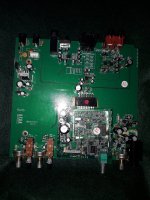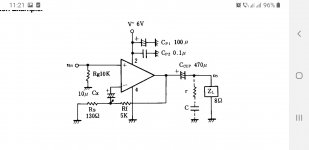I haven't seen it discussed in detail and today I bought for very cheap a s**tload of EJ-770T 860MHz transmitters having these op amps as headphones amplifiers.The rest of the audio op amps are all njm2068.Even though the datasheet of njm2073d didn't look impressive his specs were given for 8 and 4 ohms with a high capability of max 2 watts at 10% thd in 4 ohms!
The final op amp is routed as in stereo mode, but its input is mono which is a shame cause his sound on 250 ohms dt880 pro is really good with all those stock caps and God knows what particular stages and gains topologies before it.
Now what really struck me was that supplied by a cheap 12 wallwart smps ( the 9 and 5 Vregs are only for the digital supply) the output with max volumes and gains is simply inaudible, complete silence.
I'm going to route it in stereo mode with its 9 v reg in series and see the results cause I feel this op amp is an unknown gem.
The final op amp is routed as in stereo mode, but its input is mono which is a shame cause his sound on 250 ohms dt880 pro is really good with all those stock caps and God knows what particular stages and gains topologies before it.
Now what really struck me was that supplied by a cheap 12 wallwart smps ( the 9 and 5 Vregs are only for the digital supply) the output with max volumes and gains is simply inaudible, complete silence.
I'm going to route it in stereo mode with its 9 v reg in series and see the results cause I feel this op amp is an unknown gem.
Attachments
While I won't be surprised if it beats an LM386 or TDA2822M, you'll still be lucky to get less than 50 µV(A) worth of output noise out of the thing even with gain reduction as described in the datasheet (which I suspect is being used here) - quite a number of commercial headphone amps sport less than 2 µV(A) these days.
Obviously it's still good enough for a 102 dB/V class headphone like the DT880-250 (102 dB SPL - 86 dB = 16 dB SPL), and since it can do 500 mW into 4 ohms = 4 Vpp at 1% THD on a 6 V supply, I would imagine that we can expect about 10 Vpp or 3.5 Vrms on 12 V. Given the much lighter loading, you can expect crossover distortion to be reduced by about a factor of 250/4 compared to datasheet levels (well, not quite, the 0.22 µF capacitor in the Zobel network would be down to 72 ohms worth of |Z| at 10 kHz), plus the amount of external gain reduction, plus whatever beneficial effects the higher supply has in terms of common mode. In the end I won't be surprised if distortion actually turned out to be entirely hi-fi worthy (<0.01%). Should be measured easily enough with an external ca. 5:1 voltage divider (say 1k6 / 390R) and a dummy load made of one or more resistors, even if you have to contend with onboard audio.
Obviously it's still good enough for a 102 dB/V class headphone like the DT880-250 (102 dB SPL - 86 dB = 16 dB SPL), and since it can do 500 mW into 4 ohms = 4 Vpp at 1% THD on a 6 V supply, I would imagine that we can expect about 10 Vpp or 3.5 Vrms on 12 V. Given the much lighter loading, you can expect crossover distortion to be reduced by about a factor of 250/4 compared to datasheet levels (well, not quite, the 0.22 µF capacitor in the Zobel network would be down to 72 ohms worth of |Z| at 10 kHz), plus the amount of external gain reduction, plus whatever beneficial effects the higher supply has in terms of common mode. In the end I won't be surprised if distortion actually turned out to be entirely hi-fi worthy (<0.01%). Should be measured easily enough with an external ca. 5:1 voltage divider (say 1k6 / 390R) and a dummy load made of one or more resistors, even if you have to contend with onboard audio.
Thanks for the comments!
Their input noise is given for an Rs of 10k ohm while it seems that the minimum Rs is around 500 ohms for 20db gain and 300ohms for 44db gain.With njm2068 at the input I'd expect better numbers.
I've seen lately that i'm less and less impressed by too many zeros after the dot...I simply can't hear those infinitesimal distortions or noises that apear so huge in the analyser's window. With 250uV noise I'm still much better than vinyl.I wonder if it allows me to remove the Zobel on 250 ohms load...
Their input noise is given for an Rs of 10k ohm while it seems that the minimum Rs is around 500 ohms for 20db gain and 300ohms for 44db gain.With njm2068 at the input I'd expect better numbers.
I've seen lately that i'm less and less impressed by too many zeros after the dot...I simply can't hear those infinitesimal distortions or noises that apear so huge in the analyser's window. With 250uV noise I'm still much better than vinyl.I wonder if it allows me to remove the Zobel on 250 ohms load...
There's a whole bunch of IC's develloped for walkman cassette players with 40...50db gains that actually sound very well on headphones.The higher gain makes them particularly stable while the bandwidth is just good enough.I think I could use these ic's to monitor the first stage of a cassette deck before the usual dolby chip.Usually the dolby filters are placed after a first 2..10 x gain stage found inside the dolby chip and that first stage was done with a relatively good or not so good op-amp . I don't know if many of you felt that the first op-amp inside the dolby chip who's output you hear when you bypass the dolby filters is not exactly the right thing to have there because there's always a second and a third op amp with 1...2x set gain in the chain and back in the 80's and 90's those op-amps weren't particularly stable at such low gains sacrificing some of the dynamic range.
If you're going to use a very high performance op amp of today, if you need a high gain one stage circuit, the final thd will be the gain substracted from the thd figure at 1x gain so not very low anyway and tape thd and noise are high anyway.
There's some useful number gymnastics these cheap chips with 40...50 db gains makes us do and get us back on Earth from time to time.
If you're going to use a very high performance op amp of today, if you need a high gain one stage circuit, the final thd will be the gain substracted from the thd figure at 1x gain so not very low anyway and tape thd and noise are high anyway.
There's some useful number gymnastics these cheap chips with 40...50 db gains makes us do and get us back on Earth from time to time.
They made the most obvious choice...the 26 db gain structure with 33ohms in series with 220nF for the Zobel.
Thinking of wiring it in full stereo mode for the max gain and using proper caps for signal coupling as I don't get often to rework gold plated pcb's...
Thinking of wiring it in full stereo mode for the max gain and using proper caps for signal coupling as I don't get often to rework gold plated pcb's...







